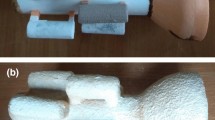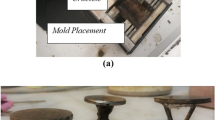Abstract
Titanium, once considered to be difficult to cast because of its relatively high melting point \(\left( {1670 \pm 50^\circ {\text{C}}} \right)\) and strong chemical affinity, can now be acceptably cast using newly developed casting apparatus. The objectives of this study were to examine the castability of commercially pure (CP) titanium using an ultra high-speed centrifugal casting machine and a pressure difference-type casting unit and to compare the castability of titanium with that of conventional dental casting alloys. To determine castability, two types of patterns were used: a mesh pattern of 22 × 24 mm cut polyether thread sieve, and a saucer pattern (24 mm diameter) perforated to create four T-shaped ends. The casting equipment significantly affected the mold filling of both patterns \(\left( {p < 0.001} \right)\). The castability indices obtained from both patterns of CP titanium cast in the centrifugal casting machine were significantly \(\left( {p < 0.05} \right)\) better than the indices of the castings produced in the pressure-difference casting unit. The radiographs of the saucer pattern cast in the centrifugal casting machine showed some pores that were fewer and smaller in size than the pores found in castings made in the pressure-difference unit. When the ultra high-speed centrifugal casting machine was used with the manufacturer’s recommended mold material, the castability of titanium was similar to that of gold alloy or Ni-Cr alloy cast by conventional means.
Similar content being viewed by others
References
E. Stenman and M. Bergma, Scand. J. Dent. Res. 97 (1989) 76.
J. A. Marcusso, Contact Dermatitis 34 (1996) 320.
T. Okabe and H. Herø, Cells and Materials 5 (1995) 211.
R. R. Wang and A. M. Boyle, J. Prosthet. Dent. 70 (1993) 275.
H. Herø, M. Syverud and M. Waarli, Dent. Mater. 9 (1993) 15.
I. Watanabe, J. H. Watkins, H. Nakajima, M. Atsuta and T. Okabe, J. Dent. Res. 76 (1997) 773.
T. Togaya and K. Ida, in Transactions of the 3rd World Biomaterials Congress, Kyoto, Japan, April 21–23, 1988 (Business Center for Acad. Soc., Tokyo, Japan, 1988) 5P–34, 575.
A. Kuroiwa, K. Wada, Y. Hibino, O. Yoshida, Y. Kakumoto, H. Kouchi, K. Nagayama and H. Hashimoto, J. Jpn. Dent. Mater. 9 (1990) 279 (in Japanese).
M. Syverud and H. Herø, Dent. Mater. 11 (1995) 14.
T. I. Chai and R. S. Stein, J. Prosthet. Dent. 73 (1995) 534.
D. H. Gehl and S. H. Payne, ibid. 28 (1972) 439.
K. Asgar, in “Dental Biomaterials-Research Priorities”, (DHEW Publ No. (NIH) 74-548, 1973) p. 27.
K. Asgar and A. H. Arfaei, J. Dent. Res. 56B (1977) 647.
Idem., J. Prosthet. Dent. 54 (1985) 60.
J. M. Meyer, C. P. Susz and R. Barraud, J. Dent. Res. 62 (1983) 342.
J. R. Mackert and J. P. Moffa, ibid. 54 (1975) 355.
M. T. Barreto, A. J. Goldberg, D. A. Nitkin and G. Mumford, J. Prosthet. Dent. 44 (1980) 504.
P. F. Vincent, L. Steven and K. E. Basford, ibid. 37 (1977) 527.
P. J. Brockhurst, V. G. Mclaverty and Z. Kasloff, Oper. Dent. 8 (1983) 130.
C. Bessing, Acta Odontol. Scand. 44 (1986) 165.
R. P. Whitlock, R. W. Hinman, G. T. Eden, J. A. Tesk, G. Dickson and E. E. Parry, J. Dent. Res. 60 (1981) 374.
R. H. Jarvis, T. J. Jenkins and L. A. Tedesco, J. Prosthet. Dent. 51 (1984) 490.
R. A. Kaminski, K. J. Anusavice, T. Okabe, P. K. Morse and P. E. Casteel, ibid. 53 (1985) 329.
S. E. Reagan and J. C. Kois, Quintessence Dent. Techno. 9 (1985) 667.
R. W. Hinman, J. A. Tesk, R. P. Whitlock, E. E. Parry and J. S. Durkowski, J. Dent. Res. 64 (1985) 134.
J. Takahashi, J. Z. Zhang and M. Okazaki, Dent. Mater. J. 12 (1993) 238.
T. Aoki, Tsurumi Dent. J. 22 (1996) 15.
C. Bessing and M. Bergman, Scand. Dent. J. 16 (1992) 109.
M. Syverud, T. Okabe and H. Herø, Eur. J. Oral Sci. 103 (1995) 327.
K. Tajima, S. Matsuda, S. Kitajima, Y. Yokoyama, H. Kakigawa and Y. Kozono, Dent. Mater. J. 13 (1994) 206.
J. Takahashi, J. Z. Zhang and M. Okazaki, ibid. 12 (1993) 245.
K. Watanabe, S. Okawa, O. Miyakawa, S. Nakano, N. Shiokawa and M. Kobayashi, ibid. 10 (1991) 128.
“Metals Handbook”, Volume 15, Casting (American Society for Metals, Metals Park, OH, 1988).
K. Watanabe, J. Japan Inst. Metals 61 (1997) 662.
Author information
Authors and Affiliations
Rights and permissions
About this article
Cite this article
Watanabe, I., Woldu, M., Watanabe, K. et al. Effect of casting method on castability of titanium and dental alloys. Journal of Materials Science: Materials in Medicine 11, 547–553 (2000). https://doi.org/10.1023/A:1008972018025
Issue Date:
DOI: https://doi.org/10.1023/A:1008972018025




